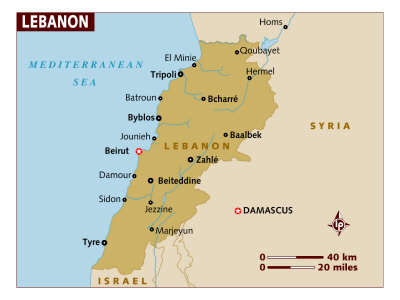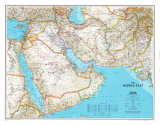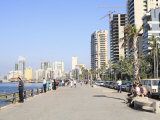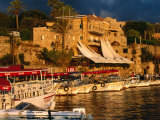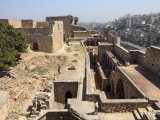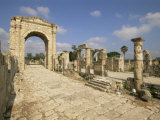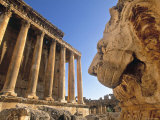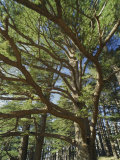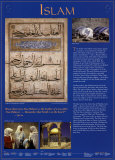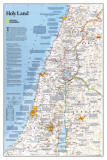|
|
Lebanon and Lebanese Culture Posters, Art Prints, Charts, Maps
|
geography > Middle East > LEBANON < social studies
|
|
The Republic of Lebanon is located on the eastern end of the Mediterranean Sea, between Israeli occupied Palestine to the south and Syria to the north and east. Present day Lebanon, the historic home of the ancient Phoenicians, has been a major cultural crossroads for millennia, invaded by Alexander the Great, the Romans, and the Crusaders, just to name a few.
Lebanon, about three fourths the size of the State of Connecticut, has a narrow coastal plain rising to a mountaineous eastern region. Lebanon has a Mediterranean climate with a hot and dry summer season and a shorter cool, rainy winter.
Lebanon's legal system is a mixture of Ottoman law, canon law, Napoleonic code and civil law without judicial review of legislative acts. The population of Lebanon is approximately 60% Muslim and 40% Christian, with a small number of other faiths represented. Suffrage for Lebanese males at 21 is compulsory, women age 21 with an elementary education may vote. The capital and largest city of Lebanon is Beirut.
|
|
|
Beirut, the capital and largest city of Lebanon, is located on a peninsula at the midpoint of Lebanon's Mediterranean coastline.
Beirut is first mentioned the 15th century BC with continuous inhabition since.
The name Beirut is from the ancient Canaanite name of Be'erot (wells), referring to an underground water table that is still used.
|
|
|
Byblos, believed by many to be the oldest continuously-inhabited city in the world, and the Middle East's first major port, is reputed to have been founded by Cronos.
The name of the city is thought to have come about because of the byblos, or papyrus, that was exported through the seaport. FYI, the word Bible is thought to have evolved from the early Greek word for papyrus.
Byblos is a UNESCO World Heritage Site.
|
|
|
|
Sidon is located on Lebanon's Mediterranean coastline and is the same word in modern Arabic for fishery.
Sidon, originating in Phoenician times, remained important under the Persians, Greeks and Romans; it's major export was glass.
FYI - Sidon received its name from the “first-born” of Canaan, the grandson of Noah (Genesis 10:15, 19). Jezebel was a Sidonian princess (1 Kings 16:31).
|
|
|
|
Tripoli, meaning three cities, was part of a confederation of Tyre, Sidon and Arados. With a history dating back to the 14th century BC, Tripoli was controlled by the Assyrians, Persians, Romans, Byzantines, Caliphate, Seljuk, Crusaders, Mamluks, Ottomans and France.
|
|
|
|
Tyre, an ancient Phoenician city and the legendary birthplace of Europa and Elissa (Dido), is located on the Mediterranean on the southern coast of Lebanon.
Because of its strategic location the area has a long history: Tyre is mentioned several time in the Old Testament; Alexander the Great laid seige to Tyre in 332 BC, after building a causeway from the mainland to the main city on an island just off shore; the area was visited by Jesus; the Crusaders captured Tyre in 1124; and the city has suffered significant damage in recent years by the violence between Israel and the Palestine Liberation Organization (PLO).
Notable people associated with Tyre include the philosopher Porphyry and the historian William of Tyre. Authors making reference to Tyre include William Shakespeare (Pericles, Prince of Tyre) John Ruskin, Rudyard Kipling, Oscar Wilde, and E. Nesbit.
|
|
|
|
Lebanon's fertile Bekaa (Beqaa) valley is the northeasternmost extension of the Jordan Rift Valley, located between the Mount Lebanon to the west and the Anti-Lebanon Mountains to the east.
The valley, which makes up 40 percent of Lebanon's arable land, was also used by the Romans for grain production.
Baalbek, a town in the Beqaa Valley, is famous for its large and well preserved temple ruins of the Roman period when the city was known as Heliopolis (sun+city). The temple at Baalbek was dedicated to the Roman god of wine, Bacchus (Greek Dionysus).
Settlement of Baalbek dates back about 9000 years, with almost continual settlement of the tell (a mound created by human habitation over many centuries) under the Temple of Jupiter, which was probably a temple since the pre-Hellenistic era. As Heliopolis, it was one of the largest sanctuaries in the Roman Empire.
Eight Corinthian columns were disassembled and shipped to Constantinople under Justinian's orders circa 532-537 CE, for his basilica of Hagia Sophia.
|
|
|
|
The Cedars of Lebanon is an ancient forest that was once the source of timber for the Assyrians, Babylonians, Persians, Phoenicians, and Egyptians. Several verses from the Bible mention the Cedars - “The righteous flourish like the palm tree and grow like the cedar in Lebanon.” (Psalm 92:12)
Only a few groves of cedars remain after millennia of cutting for ships and palaces. The “Cedars of God” (34º14'37"N 36º2'54"E) were added to the UNESCO World Heritage Sites in 1998.
FYI ~ in Mesopotamian mythology the Cedar Forest is the glorious realm of the gods where Gilgamesh dares to cut down virgin trees during his quest for immortality (tablet 4-6).
|
|
|
|
World Religions -
Islam Wall Poster
“Know that every True Believer is the brother of every other True Believer. ...Remember that Faith is in the heart.” Qur'an
The Arabic word “Islam” means peace, purity, acceptance and commitment. People who follow the Islamic religion are called Muslims. Islam in monotheistic that is, Muslims believe there is only one God. They believe Muhammad is the final and most important prophet, or messenger, of God, who is called Allah. But Muslims do not think of Muhammad as God. Muhammad lived from 570 to 632. He established Islam in Mecca, Saudi Arabia. His followers spread Islam from Mecca throughout the Arab world and beyond. The early Muslims converted people who lived in the lands the controlled in Arabia, North Africa, and Spain. Today, Islam is the world's second-largest religion – more than one billion Muslims live in the Middle East and around the world.
Muslims believe that Muhammad received the Qur'an [kuh-RAN], the Islamic holy book, from Allah. The Qur'an defines Islamic religious belief and practice. Overall, Islam teaches that a moral life can be led through complete submission to the will of Allah. In many Islamic nations, Islam is the state religion. In these countries, the law of Islam is the law of the land.
The Qur'an lists five duties that all Muslims must fulfill – these are known as the Five Pillars of Faith. Performing these duties makes up much of the day-to-day religious practice of Muslims. The first duty is shahadah, or testimony that "There is no god but Allah, and Muhammad is his prophet!" The next is salah, or prayer. Devout Muslim pray five times daily. The third duty is zakah, the giving of alms, or charity, to the poor. The fourth duty is sawm, or fasting. Muslims fast during the month of Ramadan, the time when Muhammad received the Qur'an. The final duty is hajj, or pilgrimage. If they are able, Muslims must visit the holy city of Mecca at least once in their lives.
• more Islam posters
• more World Religions posters
|
|
|
|
Lands of the Bible
Historical Periods
• STONE AND BRONZE AGES (ca 500,000 to 1200 BC.) The layering of settlements at tells, or mounds, marks ancient sites in the Holy Land dating back to the Stone Age. By 3000BC walled towns were common; 15 centuries later, Canaanite city-states were controlled by Egypt's pharaohs.
• ISRAELITE & PERSIAN PERIODS (ca 1200 to 332 B.C.) Seminomadic Israelite tribes united as a monarch to challenge local Philistines and Canaanites. Solomon's grandiose kingdom split and later fell to Assyrians and Babylonians. Exiled Israelites returned under Persian rule.
• HELLENISTIC & ROMAN PERIODS (332 B.C. to A.D. 324) Alexander's military successors carved up the lands he took from Persia. Jews struggled for independence. Roman conquerors at times imposed their own worship at the sites sacred to Judaism and budding Christianity.
• BYZANTINE PERIOD (A.D. 324 to 640) Constantine's conversion made Christianity secure for three centuries under the Byzantine Empire, with Jerusalem the spiritual center. Churches and monasteries proliferated, and the surge of pilgrims boosted development.
• ISLAMIC PERIOD (A.D. 640 to 1917) Muslim Arabs swept the region, stamping it with their new faith. The 200-year crusader campaign to retake and hold the holy places left a legacy of castles and abbeys–many leveled by Egypt's Mamluks, the predecessors of the Ottoman Turks.
• more theology posters
• more maps posters
|
|
|
|
South Asia and the Middle East-
The silk industry around Mount Lebanon in Syria prospered for many years. This region, which is now Lebanon, is rugged and mountainous. Many Lebanese people earned a living by cultivation silkworms and weaving the delicate threads into cloth. The Lebanese were also potters, craftsmen, and farmers. Then in 1869, the Suez Canal in Egypt opened, proving a shorter route between Europe and the Far East. Europeans started to buy their silk from China instead of Lebanon. The loss of the silk trade was only one problem the Lebanonese faced at that time. By the last half of the 19th century, the population of Syria had greatly increased, and the amount of arable land had decreased. Lebanese people looked to the United States as a land of opportunities. Lebanese families often combined their resources to send promising young people to America. These immigrants, in turn, sent part of their earnings back to their families. Lebanese immigrants did not want to work in factories or mines. So many took up a completely new profession. Both men and women became peddlars. For a small investment or for credit, peddlars filled backpacks and suitcases with small items, such as laces, tools, and kitchenwares. Each day, they trampled many miles carrying their heavy packs. They sold their products to housewives and people who worked all day in factories and could not always get to stores. Lebanese peddlers met many other Americans every day. They quickly learned English and American culture. ... .
• A Nation of Immigrants posters
|
|
previous page | top
|
|
I have searched the web for visual, text, and manipulative curriculum support materials - teaching posters, art prints, maps, charts, calendars, books and educational toys featuring famous people, places and events - to help teachers optimize their valuable time and budget.
Browsing the subject areas at NetPosterWorks.com is a learning experience where educators can plan context rich environments while comparing prices, special discounts, framing options and shipping from educational resources.
Thank you for starting your search for inspirational, motivational, and educational posters and learning materials at NetPosterWorks.com. If you need help please contact us.
|
|
|










